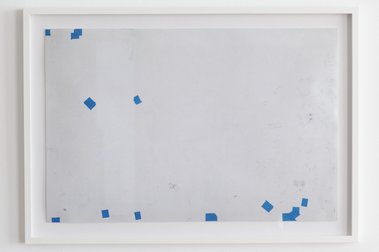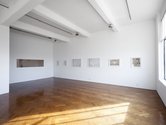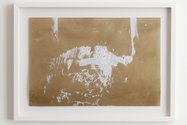John Hurrell – 17 July, 2012
Part of the interpretation of these traces comes from how Maloy has cropped his shots - what he has left out just outside the frame to be ignored. By doing this he creates a new intensity by loading found marks up with the viewer's own potentially explanatory fiction; new narrative relationships that interact internally within the edges.
This is a presentation of photos Richard Maloy made during his residency at Headlands in San Francisco in 2010. Here in Auckland he has already presented some drawings of himself made by life models there. This show though continues the approach shown in his series of documented Elam studio desktops where he looked at random marks left by students working on horizontal surfaces.
This time in this American variation however, many of the ‘forensic’ traces are on vertical walls, or portable pieces of brown or white paper, and the marks byproducts of executed projects, experimental speculation or doodling by another artist in his own studio. This artist (Hadi Tabatai) let Maloy wander into his studio in his absence so he could photograph any try-outs, leftovers, rubbish or mess that he found interesting.
Maloy’s results are strangely amusing. It is as if art was an illegal activity and he a snooping policeman looking for evidence. The lifesize images are very finely detailed, and so you guess about the physical processes involved - what caused certain clusters of encrusted substances, oily smudges, striations and stains; what created certain rows of severed pieces of blue tape, or pairs of nail holes?
Often there are scribbled words or tiny drawings of objects. There is also in the back gallery of a series of photographs of half used sheets of sand and glasspaper abandoned after being used to smooth crinkly plaster surfaces. These are slightly bigger than lifesize.
Of course part of the interpretation of these traces comes from how Maloy has cropped his shots - what he has left out just outside the frame to be ignored. By doing this he creates a new intensity by loading found marks up with the viewer’s own potentially explanatory fiction; new narrative relationships that interact internally within the edges.
One wonders what has guided his selection - to zero in on some marks, and disregard others. Of these images of selected traces those on an almost completely bare wall are subtly elegant. One image is of smeared plaster on brown paper, another of wiped ink daubs from a floppy brush. They hold your interest - both as composition and process. The elements pull together and are not hovering in the independent isolation that you might expect with such Cagean procedures. They seem positioned with intent; planned so that your excited eye will linger and explore.
John Hurrell
Recent Comments
Erin Driessen
http://store.sho.com/dexter-framed-blood-spatter-prints/detail.php?p=365781 a bit of process porn for the crime show era?














 Advertising in this column
Advertising in this column Two Rooms presents a program of residencies and projects
Two Rooms presents a program of residencies and projects



This Discussion has 1 comment.
Comment
Erin Driessen, 11:18 a.m. 17 July, 2012 #
http://store.sho.com/dexter-framed-blood-spatter-prints/detail.php?p=365781
a bit of process porn for the crime show era?
Participate
Register to Participate.
Sign in
Sign in to an existing account.